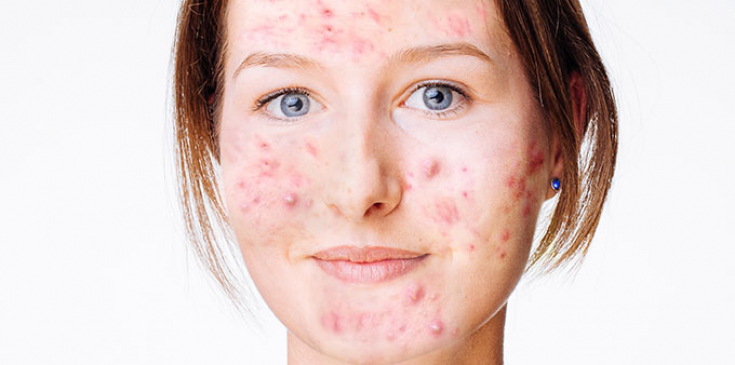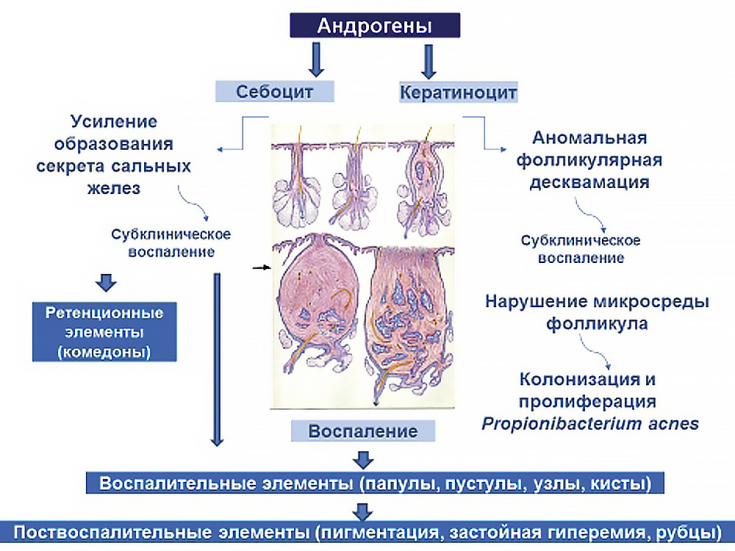According to the statistics of American researchers, about 85% of people, either in adolescence or in adulthood, encounter the problem of acne. Acne – one of the most common inflammatory skin diseases. Acne is a serious cosmetic and psychological problem, especially when it comes to severe and advanced forms of pathology.
Many factors influence the development of acne, among which hormonal instability and some microorganisms play the most significant role.
Read this article about the trigger factors for the development of severe forms of acne, as well as their impact on the course of the disease.
Severe acne: the main trigger factors for the development of the disease
Acne disease (acne) — chronic inflammatory disease of the sebaceous-follicular structures of the skin, localized mainly in areas of high concentration of sebaceous glands: face, chest, upper third of the back.
The duration and severity of acne depends on many factors: the level of tissue dehydrotestosterone, linolenic acid, the activity of the enzyme 5L-reductase and 17 β-hydroxygenase, keratinization of the ducts of the sebaceous glands, the characteristics of the skin microbiome, concomitant endocrine pathology, immune-inflammatory reactions in the lesion and in the body as a whole.
However, the factors contributing to the development of severe forms of acne, and their sequence are not fully understood.
According to the classification of acne proposed by the American Academy of Dermatology, there are four degrees of severity of the disease:
1. comedonal;
2. papulo-pustular;
3. knotty;
4. nodular cystic.
Severe forms of acne include 3rd and 4th degrees of severity of the disease.
Follow our news in Telegram
Influence of bacteria on the development of severe forms of acne
The first manifestations of the disease are hypersecretion of sebum, closed and open comedones. The progression of the process leads to a change in the rheological properties of sebum, a decrease in the level of α-linolenic acid and the formation of sebaceous-keratotic plugs. Acne develops due to the colonization of facultative anaerobes Propionibacterium acne and Propionibacterium granulosum.

These microorganisms have a direct influence on the development of both inflammatory and non-inflammatory elements in acne.
The ability of P. acne to produce vasoactive amines, which are structurally similar to histamine and capable of maintaining inflammation in the sebaceous-follicular segment, has been established.
A stable immune-inflammatory reaction is gradually formed, associated with the activation of T-lymphocytes, Langerhans cells, eosinophils, monocytes and the intensity of their release of hydrolytic enzymes.
Endocrine disorders: the role of hormones in the development of acne
An important role in the development and maintenance of inflammation in acne is played by the endocrine system.
It must be remembered that the free testosterone level in most acne patients remains within the normal range, with a tenfold increase in the conversion of testosterone to dihydrotestosterone (DHT).
In the cytoplasm of sebocytes there are enzymes 3/17 β-hydroxygenase and 5L-reductase, which affect the metabolism of testosterone. β-hydroxygenases are involved in the transformation of adrenal androgens, and 5L-reductase stimulates the conversion of free gonadal testosterone into DHT. Further, DHT binds to sebocyte receptors and stimulates the destruction of sebaceous cells, thus increasing the secretion of sebum.
 Other factors affecting disease severity
Other factors affecting disease severity
An important role in the development of severe forms of acne is played by genetic predisposition, or rather, increased sensitivity of the sebaceous glands to sex hormones. Do not forget about the influence of bad habits and external factors on skin sebum regulation.
Excessive consumption of B vitamins and proteins can also aggravate the course of the disease. Thank you for staying with estet-portal.com. You may also be interested in other articles in the "Dermatology" section: Retinoids: a revolutionary tool to combat acne and photoaging







Add a comment